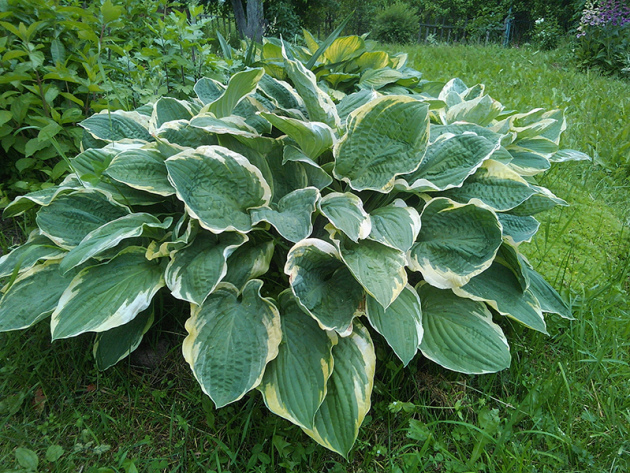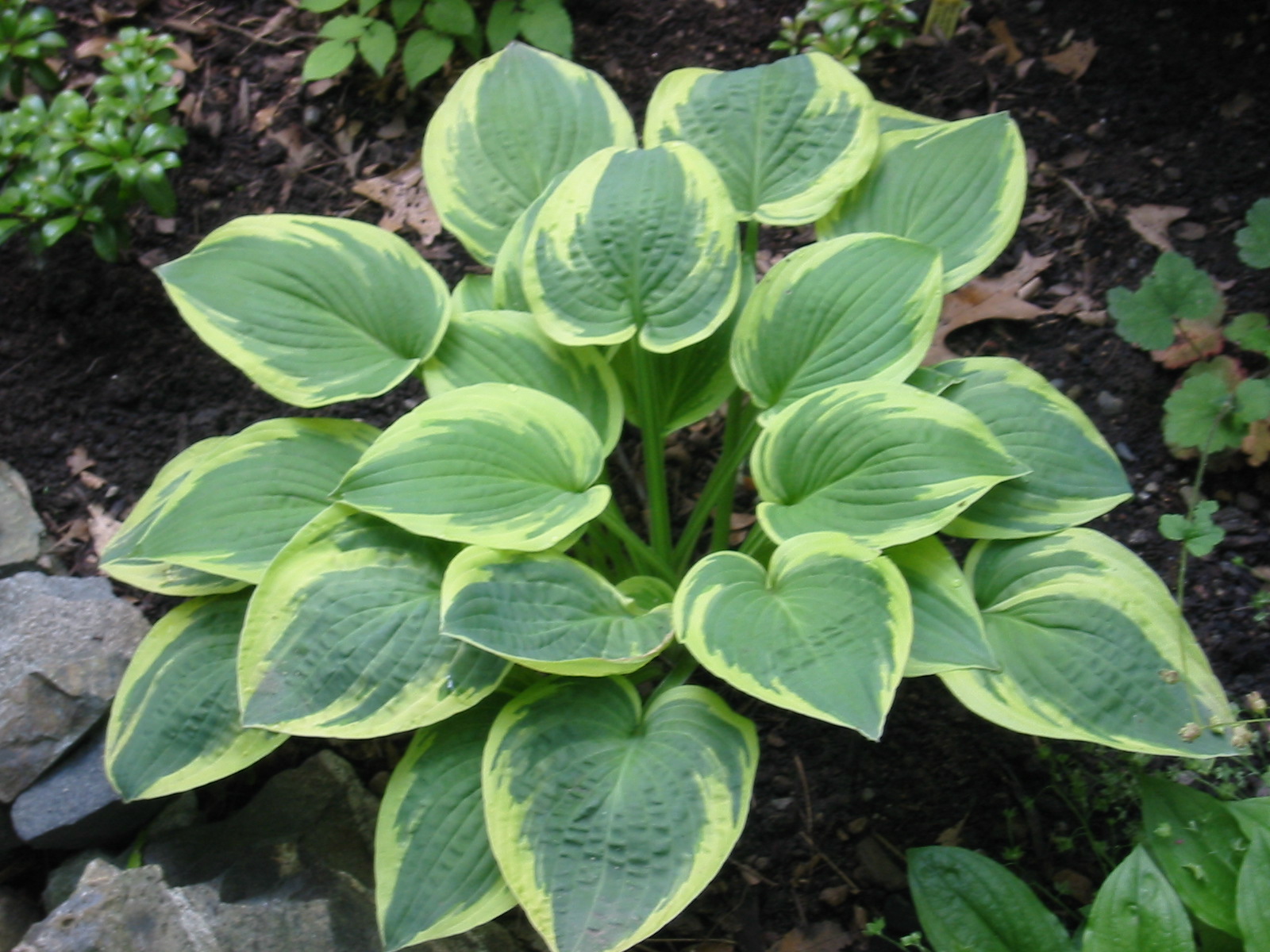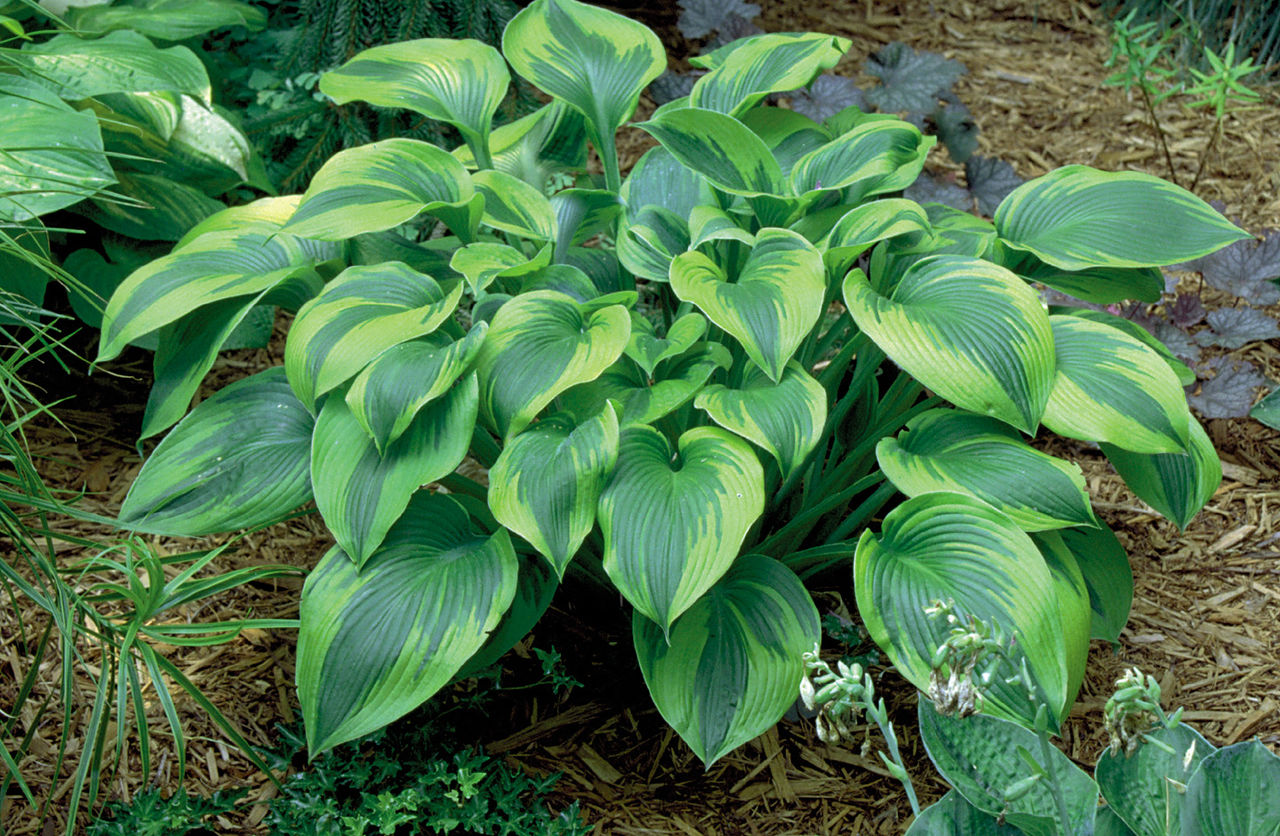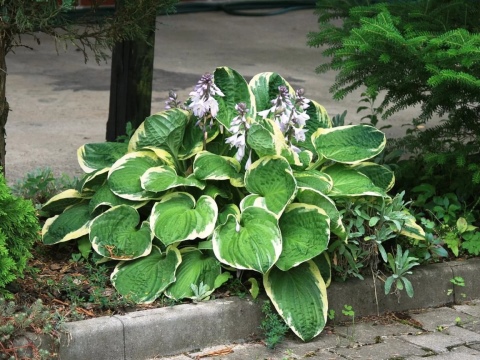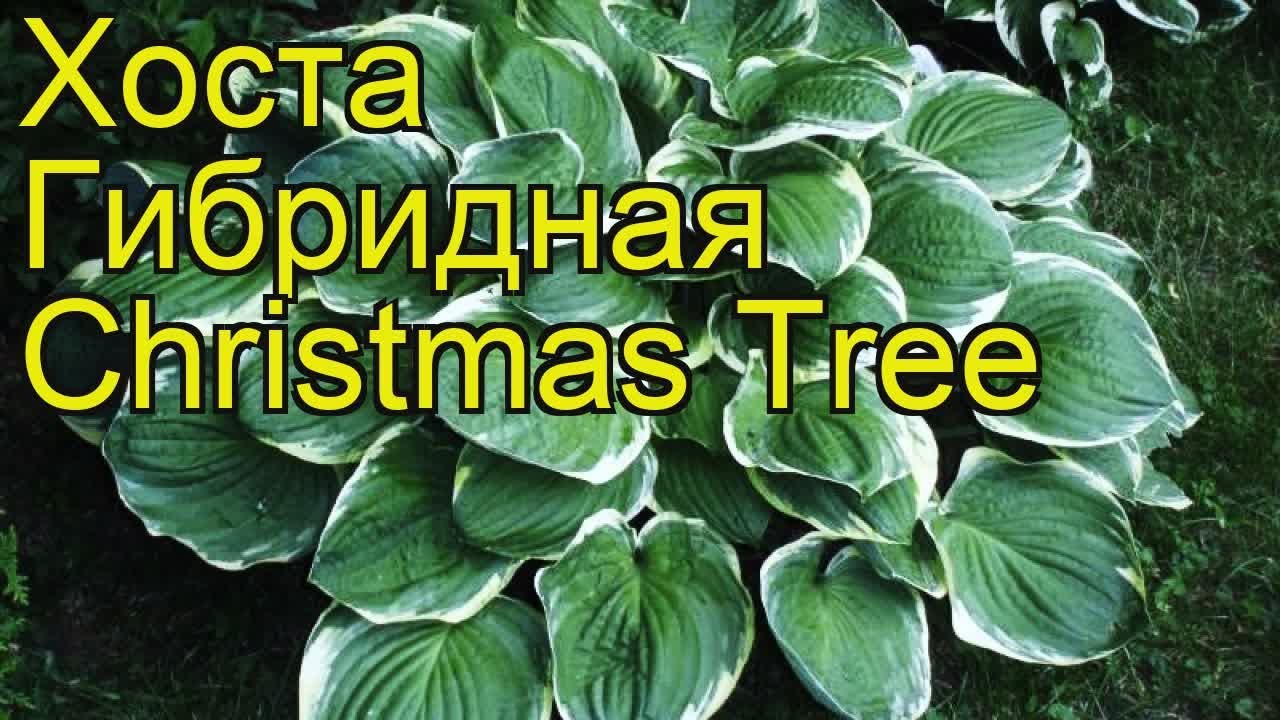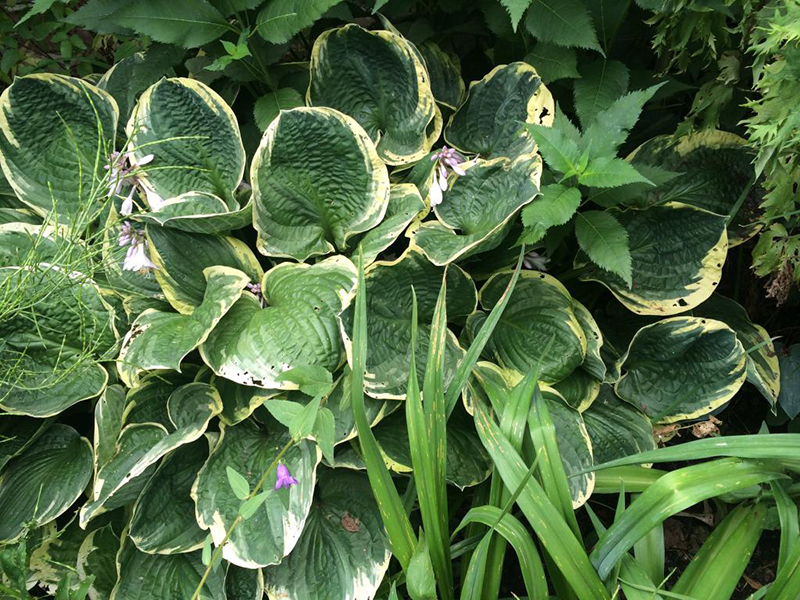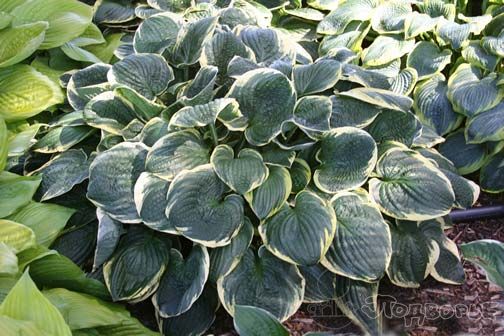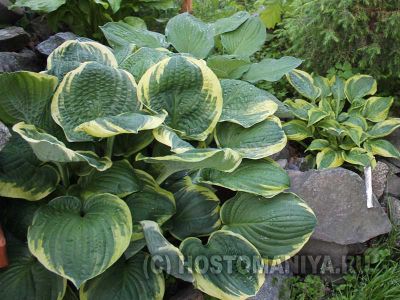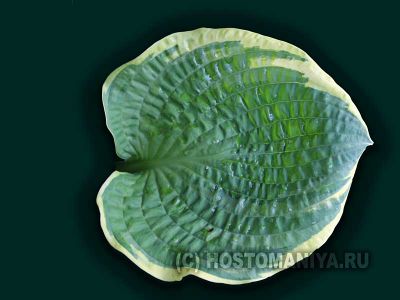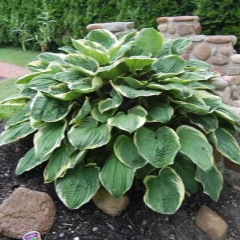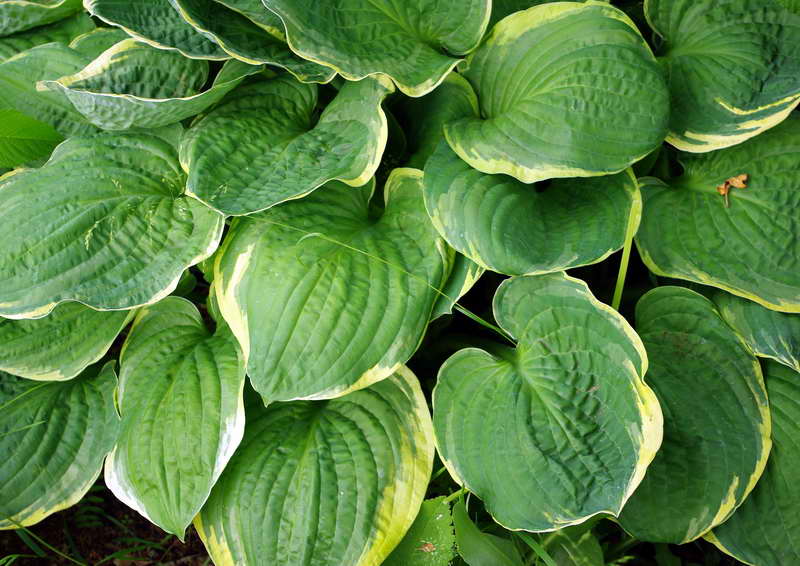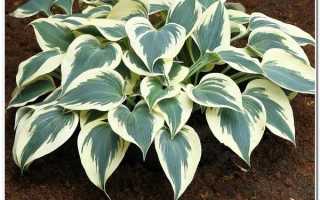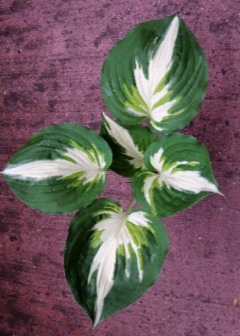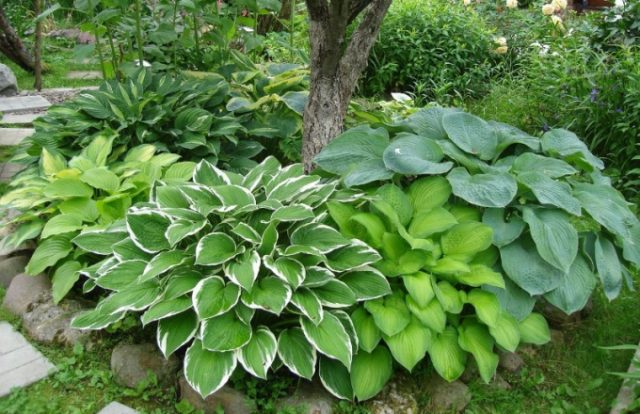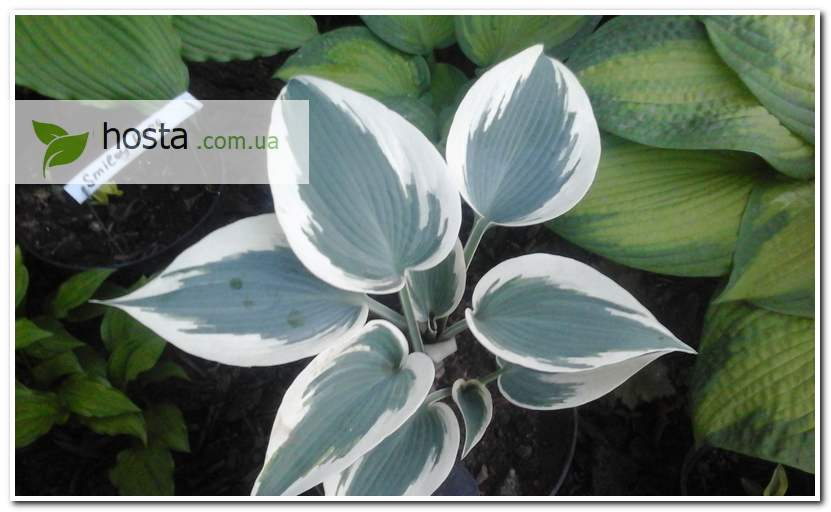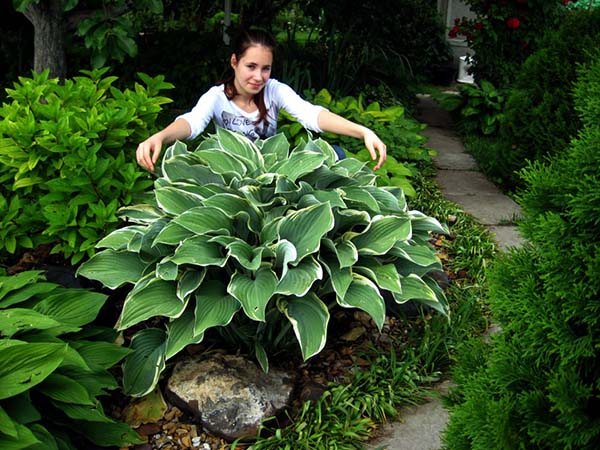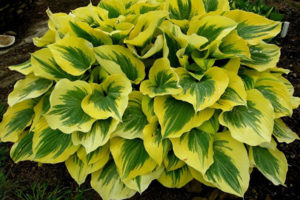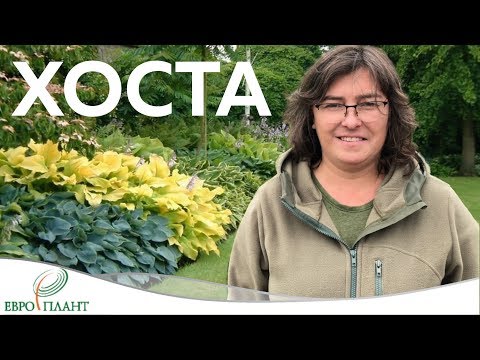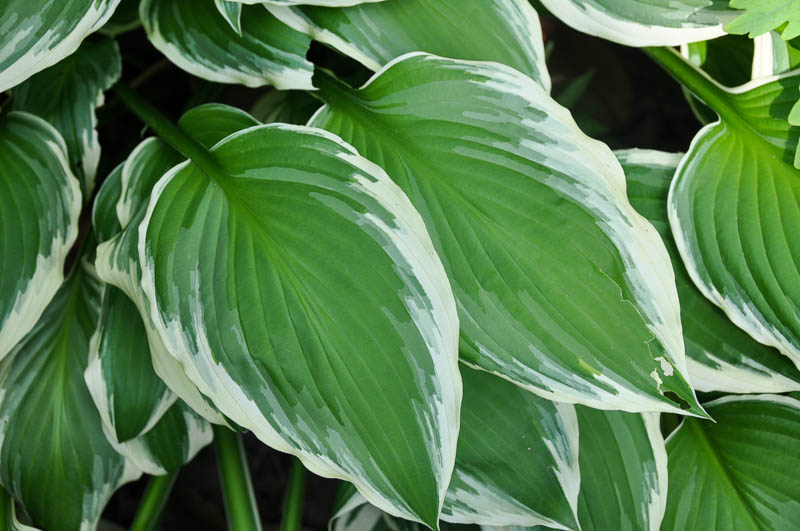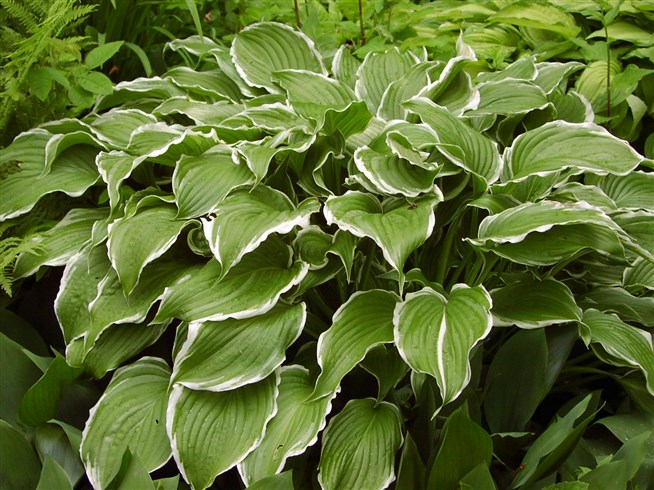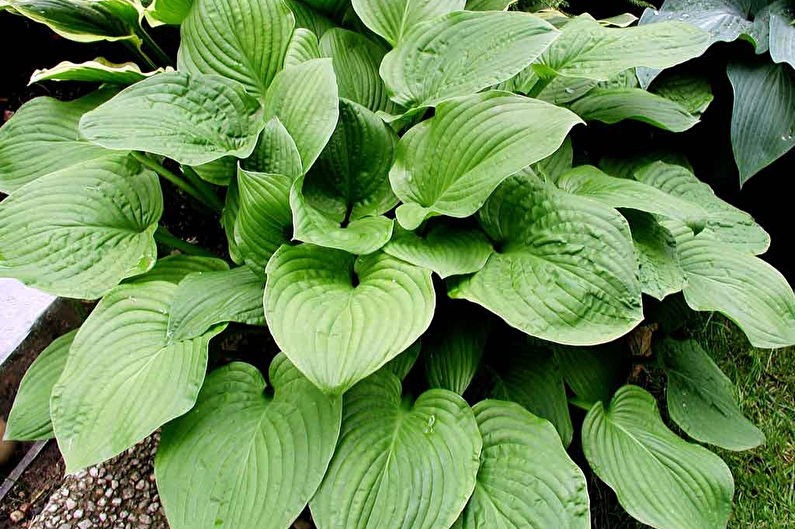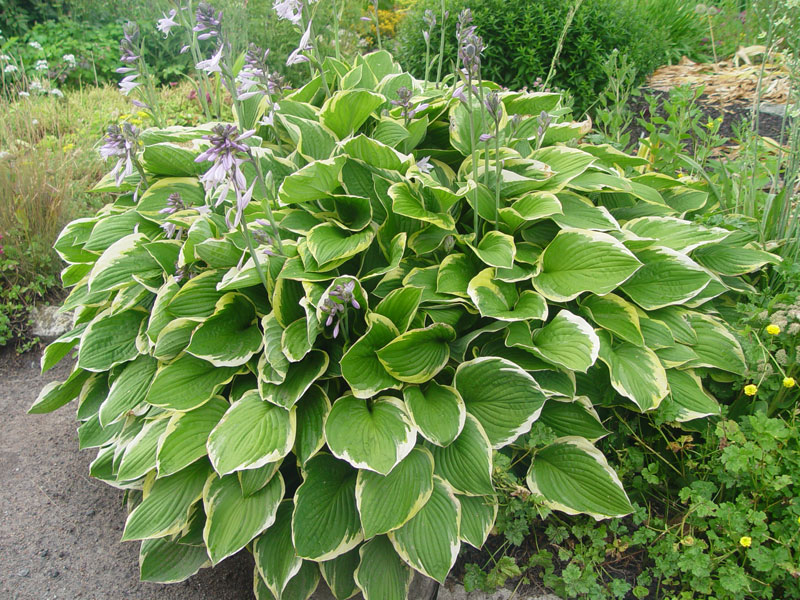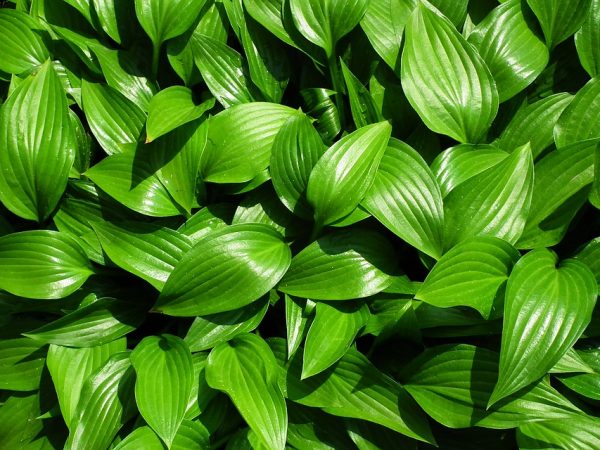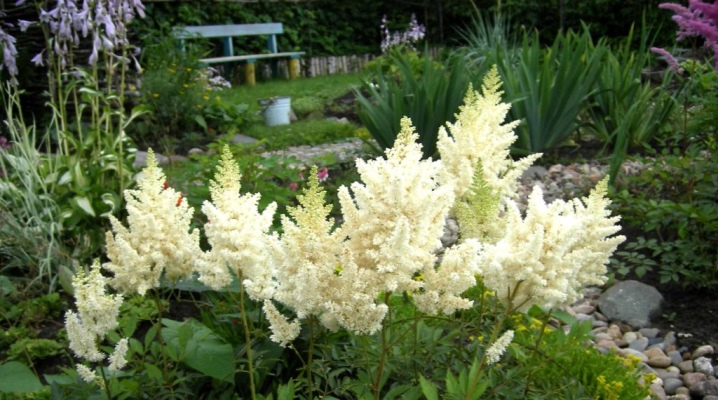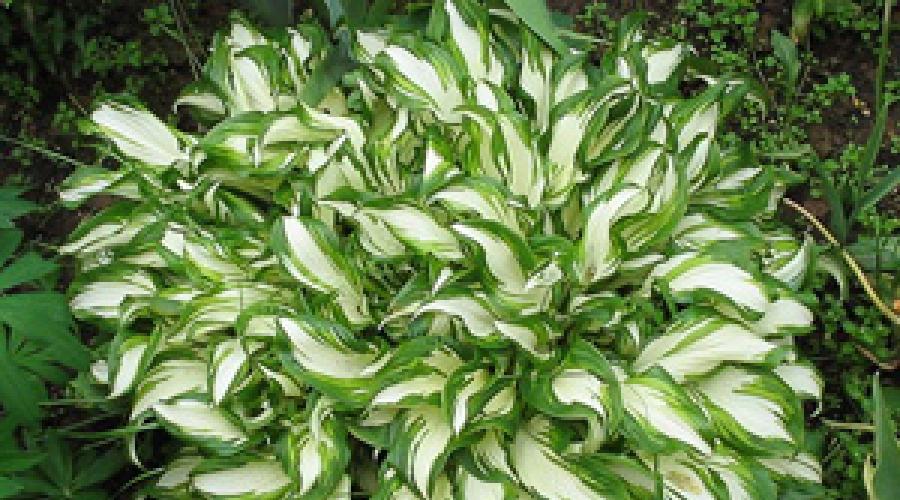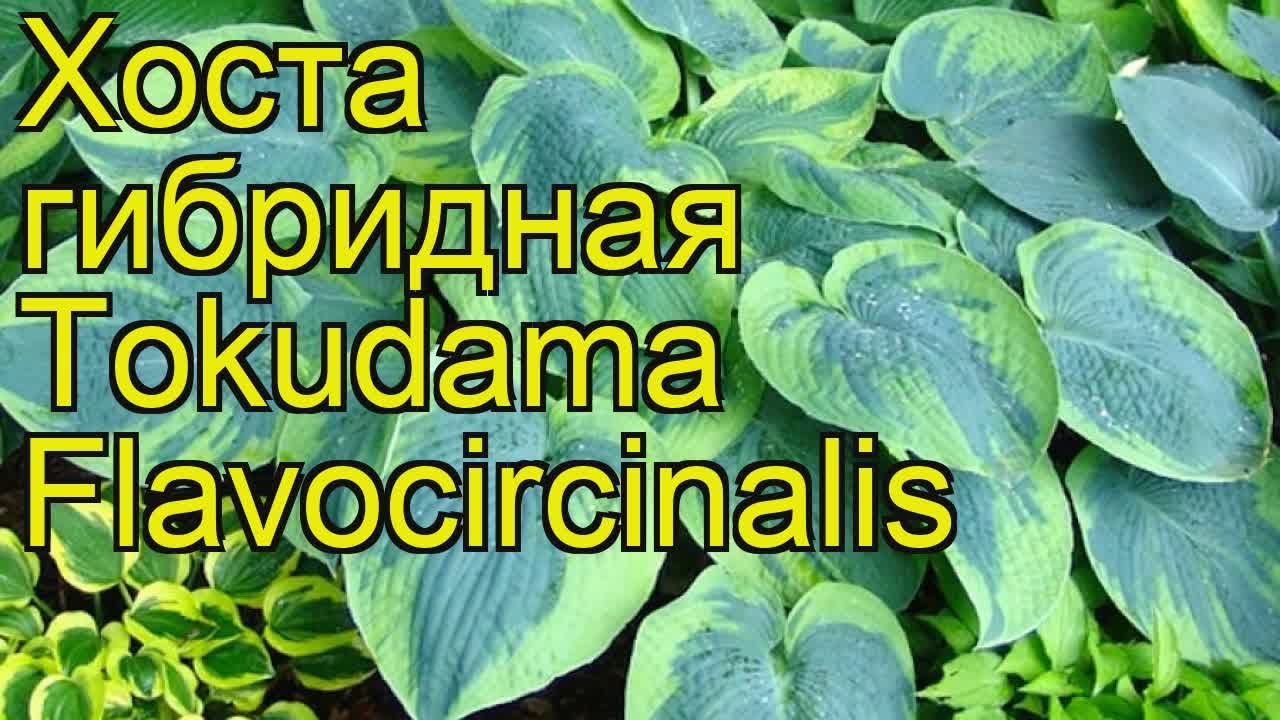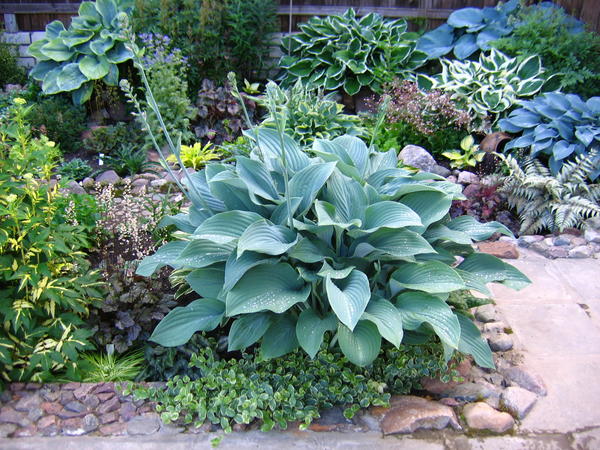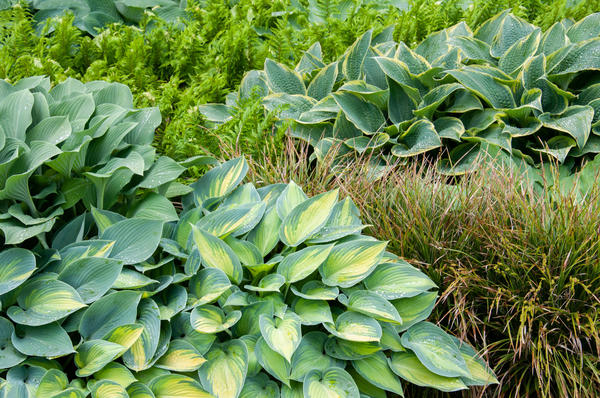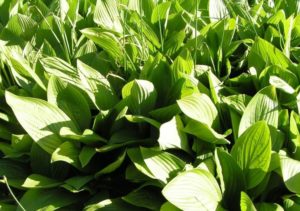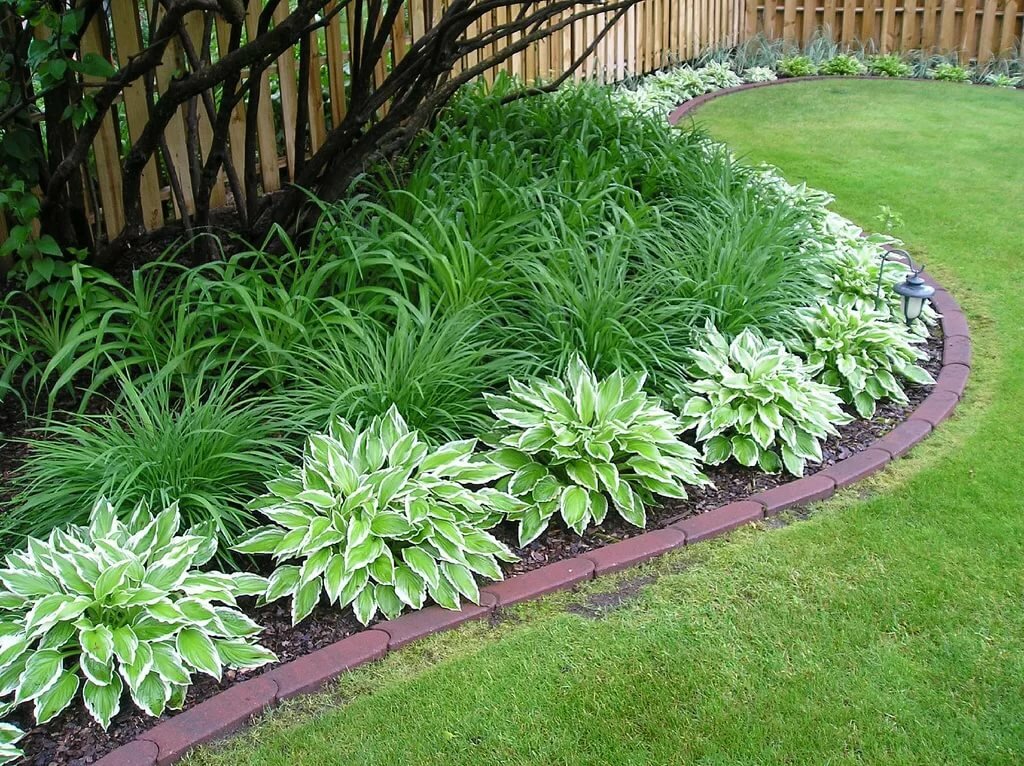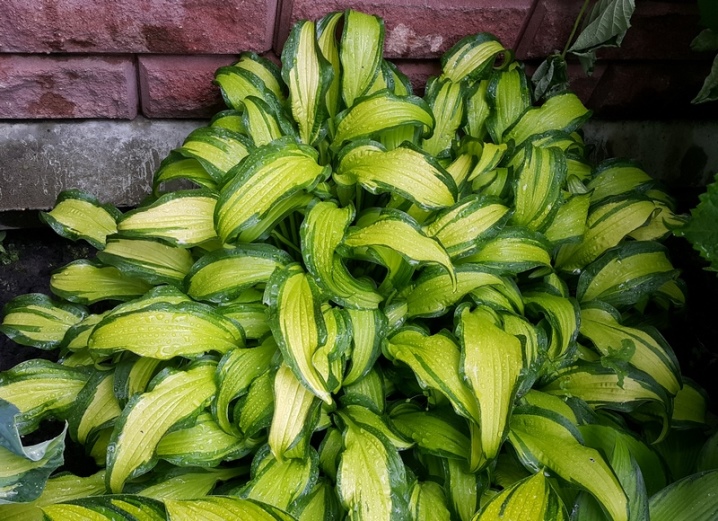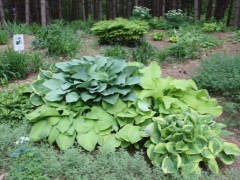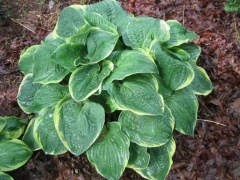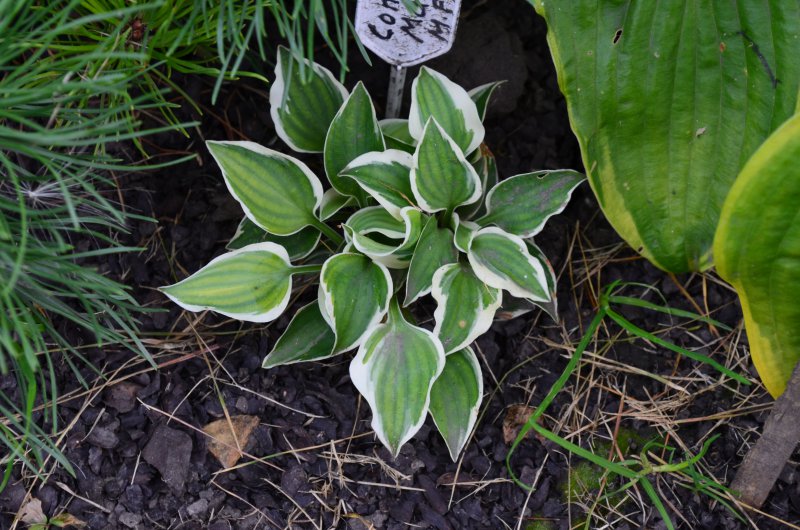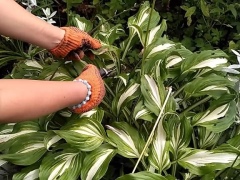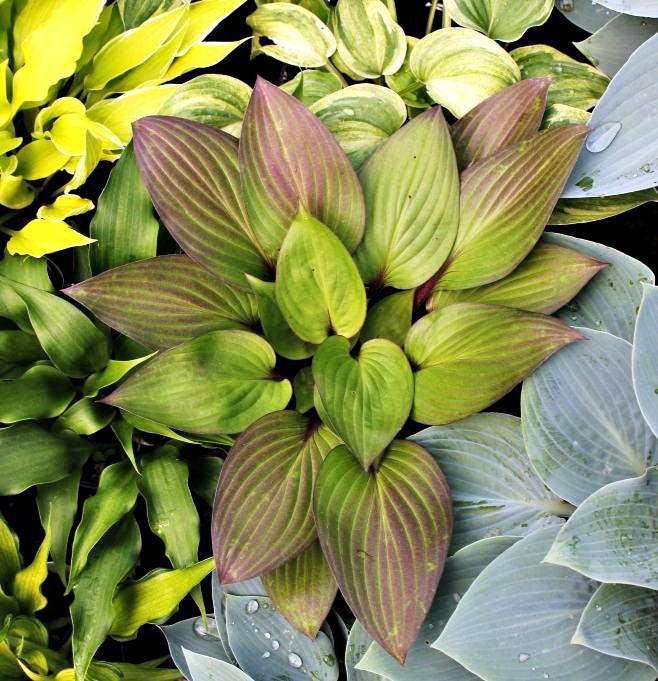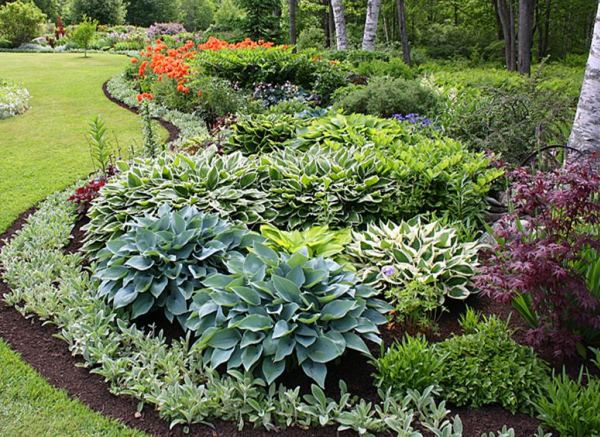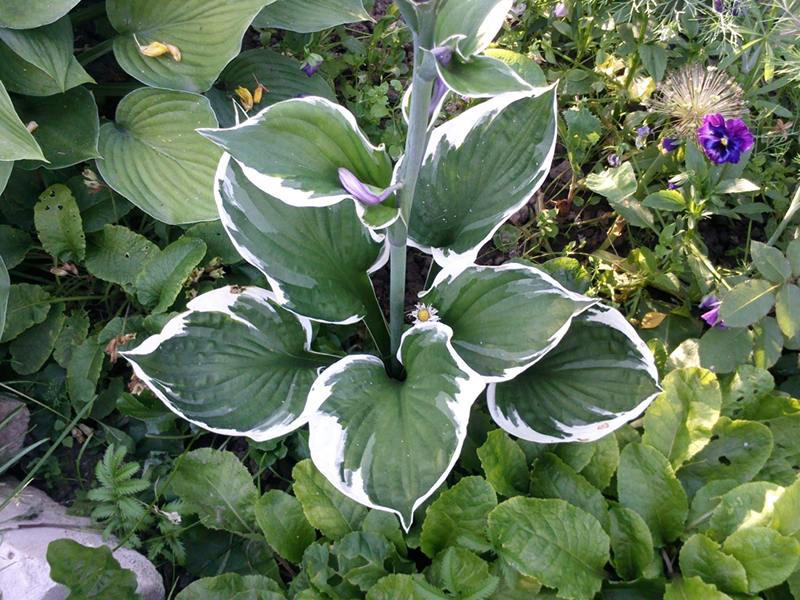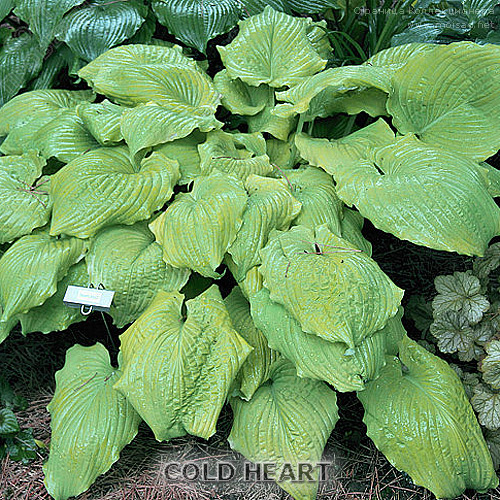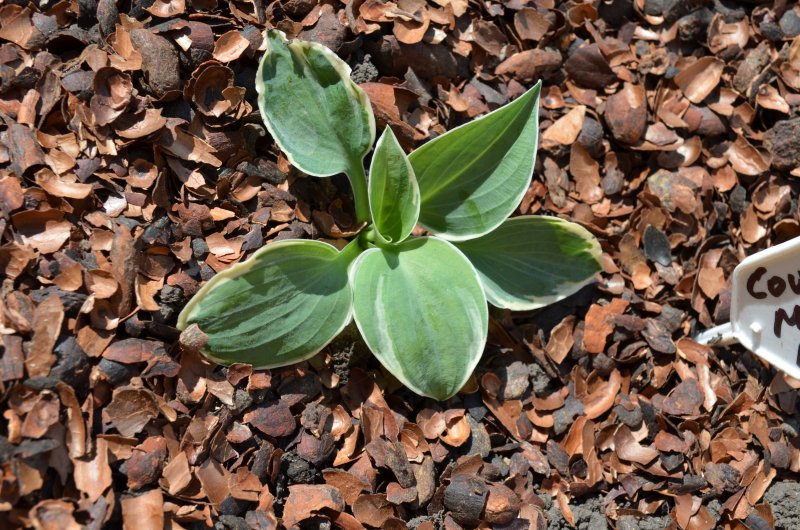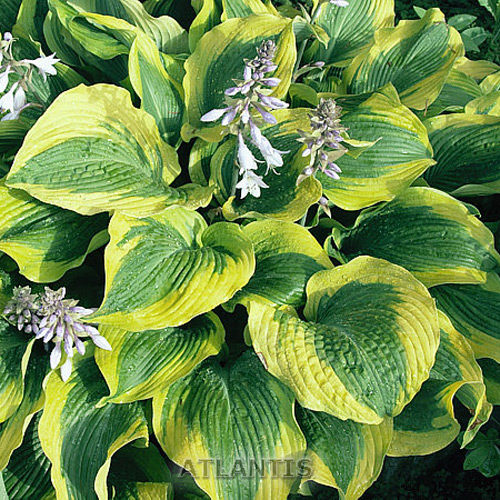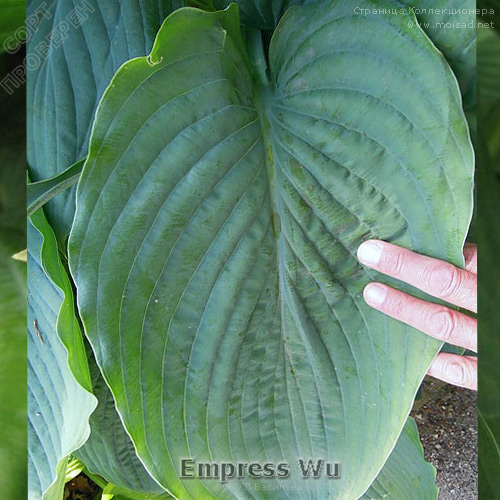Growing rules
Caring for the Christmas Tree host is not difficult and does not take much time, so even novice gardeners can do it. It is enough to regularly water the bushes, loosen and rid the soil of weeds, and also adhere to the feeding schedule.
Christmas Tree likes the soil in which it grows to always be slightly moist. Usually, flower beds are watered 3-4 times a week, as the topsoil dries out. During dry periods, watering should be done almost every day. It is advisable to do this in the early morning or evening, before sunset, watering the hosta at the root. Getting on the leaves, moisture will drain into the center of the outlet, which will lead to rotting of the bush.
If the hosta planting rules were followed (applying organic fertilizers to the flower beds and a special substrate in the planting pit), the plant does not need additional feeding for the first 3-4 years. Further, "Christmas Three" should be fertilized 3 times per season:
- In the spring - during active growth.
- In the summer - before flowering.
- Closer to the beginning of autumn, after flowering.
The plant grows better in partial shade
At the same time, complexes with an increased content of superphosphates, ammonium nitrate and potassium sulfate are introduced. You must try not to overfeed the bushes.
Because the Christmas Tree hosta loves breathable soil, the beds need to be loosened regularly to provide fresh air to the root system. Twice a season, fresh mulch should be poured under the bushes, removing the old one. This is done so that the soil does not compact and remains moist longer.
Preparing for winter
In order for Hosta Christmas Tree to spend the winter safely, you should take care of this in the fall. Preparation for winter consists in pruning the bush and providing timely shelter from frost.
Pruning - the process is not laborious and comes down to the removal of peduncles. This is necessary so that the hosta does not waste its energy on seed formation. It is not recommended to touch the foliage, as this will stress the plant. In the fall, it is impossible to remove dried leaves - they will serve as a natural covering material, usually this is done in the spring.
Important! Pruning "Christmas Three" should be done in late autumn, otherwise the host will throw all his strength into recovery and will be weakened by the onset of cold weather. In regions with harsh winters, dead leaves are not enough to shelter from the piercing frosty winds.
Therefore, the bushes are mulched with a layer of dry cut grass, rotten sawdust or peat
In regions with harsh winters, dead leaves are not enough for shelter from the piercing frosty winds. Therefore, the bushes are mulched with a layer of dry cut grass, rotten sawdust or peat.
Shrubs "Christmas Tree" can be additionally covered with a special covering material, simply by throwing it on top and pressing the edges to the ground with the help of stones.
The plant does not need winter feeding, the last time fertilization is applied in August. Hosta Christmas Tree naturally prepares for wintering.
Diseases and pests
Most often, "Christmas Tree" is affected by various diseases in the spring, being weakened after winter. This could be:
- sclerotinia - affects the root system;
- gray rot - plant leaves suffer;
- philostricosis - manifested by yellowish spots on the leaves.
All of these diseases are of fungal origin and are treated by spraying with fungicides or dichlorane.
For the Christmas Tree hosts, the most dangerous pest can be a slug. A sign of damage is holes in the leaf plates.
Often diseases appear due to excess moisture
Another, no less dangerous, enemy is nematodes. Their presence can be identified by characteristic spots on the leaf. And if you can easily get rid of slugs by simply leaving an open container of beer under the hosta bush, then the plant affected by nematodes will have to be removed and burned.
Landing
For planting, hosta seedlings, prepared cuttings and shoots taken after dividing the bush are suitable. Used and purchased in specialized centers seedlings with a closed root system, placed in a nutritious substrate of peat and humus
In this case, one must pay attention to the condition of the leaves and stems, which should not be damaged - it is better to purchase plants planted in pots. The roots should also be healthy, ideally their length is from 10 to 12 cm
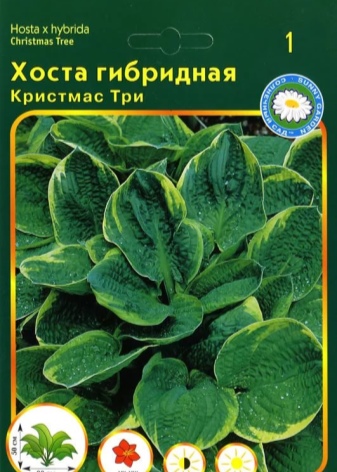
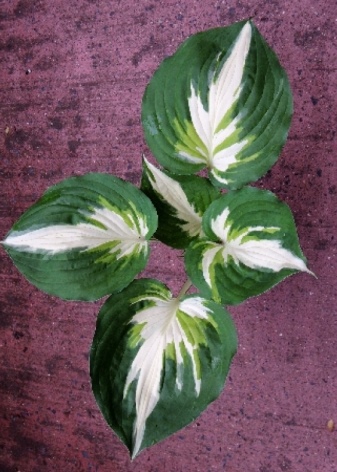
The rules for choosing a site for hosts of this variety provide for planting in partial shade and diffused lighting. These are the most favorable conditions for a plant to acquire a decorative appearance. In an open space, the culture is not planted, since the sun's rays can leave burns on the leaves.
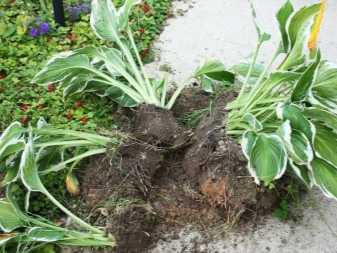
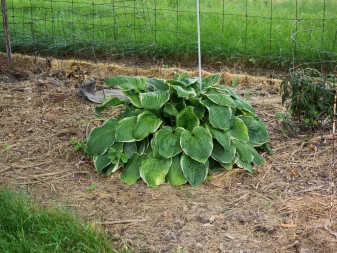
Suitable soil for the Christmas Three hosts is fertile land with good drainage. The best option is a sandy loam mixture with good air permeability. When growing a shrub, moisture stagnation should be avoided, as this causes plant diseases. Another feature of the variety is its love for slightly acidic soils. Site preparation consists of digging, removing weeds, loosening. The land should be enriched with organic fertilizers and only then the seedlings should be placed in open soil.
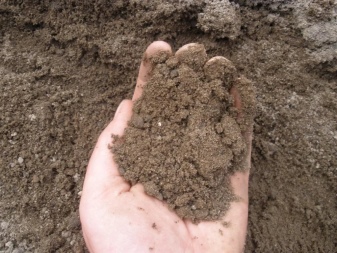
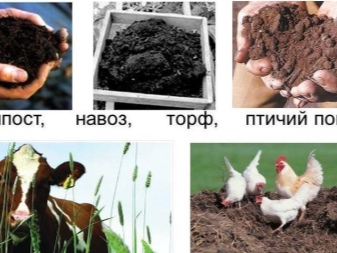
The main stages of planting look like this.
- Landing is carried out in April or early May when the ground is warm and there is no frost.
- A landing hole 30 cm deep is being prepared, which is quite spacious for the branched roots of the hosta, who love to grow to the sides.
- If it is necessary to plant a group of plants, the interval between the holes is about 1 m.
- After spilling the pit with water, drainage materials are placed in it - pebbles or coarse sand.
- Seedlings with open roots are soaked in water before being placed in open ground and kept in a stimulator for early rooting, too long and dry shoots are cut off.
- On top of the drainage, 2/3 of the hole is covered with nutritious soil (humus and peat).
- When placing the roots, they are straightened and buried to the root collar, the soil is compacted and watered with a sufficient volume of water for maximum moisture.
At the end, mulching is carried out using peat and coniferous bark, which has disinfecting properties.
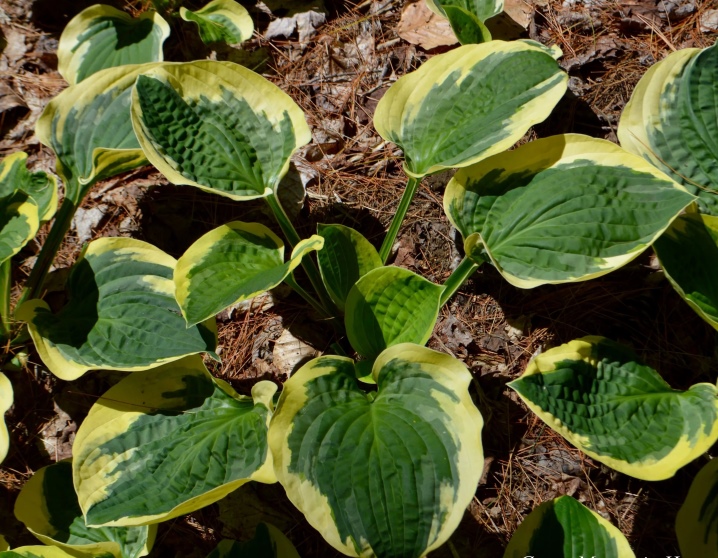
Description of Christmas Tree hosts [edit]
| DIRECTORY of host varieties: | |||||||||||||||||||||||||
| A | B | C | D | E | F | G | H | I | J | K | L | M | N | O | P | Q | R | S | T | U | V | W | X | Y | Z |
|---|
| Description of hosts Christmas tree | |
|---|---|
|
|
|
|
|
|
| Bush hosts Christmas tree | |
| The size: | Large (L). |
| Bush height, cm: | 58 |
| Bush width, cm: | 140 |
| Bush shape: | Domed |
| Lighting conditions: | Any. It grows in the shade and in the sun, partial shade is better. |
| Slew Rate: | Fast |
| Hosta sheet Christmas tree | |
| Color in the center of the leaf: | Dark green |
| Leaf border color: | Creamy white |
| Variation: | Along the edge of the sheet |
| Color change: | Constant does not change throughout the season. |
| Leaf shape: | Round |
| Sheet base: | Heart-shaped. |
| Sheet length, cm: | 45 |
| Sheet width, cm: | 38 |
| Leaf texture: | Dense |
| Flowering hosts Christmas tree | |
|
|
|
| Peduncle height, cm: | 80 |
| Colour: | Pale lavender |
| Drawing on a flower: | No |
| Flower smell: | No |
| Flowering time: | July |
| Seeds: | knotted, purple pods |
| Hosta history Christmas tree | |
| Registration year: | 1982 |
| Place of registration: | USA, Mississippi |
| Originator: | Dr. Kevin Vaughn and Mildred Seaver |
| Origin: | Seedling Frances williamsNSBeatrice |
Hosta varieties Christmas tree can also be found under the names: Christmas Tree.
Possible translation: Christmas tree.
Appearance
Christmas tree very popular hosta, one of the most famous varieties. Castings are dark green, moderately corrugated. The border is white, there are transitional shades on the sheet. In the spring, at the time of the start, the border has a yellow tint, then turns white.The leaf is round, the base of the leaf is heart-shaped. The bush is large, the growth rate is fast. Very unpretentious, showy host.
Pick-up location
Host Christmas tree It is best to grow in light shade, although it is quite resistant to the sun. The color of the leaves is very stable, practically does not change depending on the place of planting and the time of year. Christmas tree looks equally gorgeous in a sunny place and in the shade.
Designedit
Looks great in large groups, and single plants, in the company of a smaller host. A very vigorous dense bush.
Landing
For planting, hosta seedlings, prepared cuttings and shoots taken after dividing the bush are suitable. Used and purchased in specialized centers seedlings with a closed root system, placed in a nutritious substrate of peat and humus
In this case, one must pay attention to the condition of the leaves and stems, which should not be damaged - it is better to purchase plants planted in pots. The roots should also be healthy, ideally their length is from 10 to 12 cm


The rules for choosing a site for hosts of this variety provide for planting in partial shade and diffused lighting. These are the most favorable conditions for a plant to acquire a decorative appearance. In an open space, the culture is not planted, since the sun's rays can leave burns on the leaves.


Suitable soil for the Christmas Three hosts is fertile land with good drainage. The best option is a sandy loam mixture with good air permeability. When growing a shrub, moisture stagnation should be avoided, as this causes plant diseases. Another feature of the variety is its love for slightly acidic soils. Site preparation consists of digging, removing weeds, loosening. The land should be enriched with organic fertilizers and only then the seedlings should be placed in open soil.


The main stages of planting look like this.
- Landing is carried out in April or early May when the ground is warm and there is no frost.
- A landing hole 30 cm deep is being prepared, which is quite spacious for the branched roots of the hosta, who love to grow to the sides.
- If it is necessary to plant a group of plants, the interval between the holes is about 1 m.
- After spilling the pit with water, drainage materials are placed in it - pebbles or coarse sand.
- Seedlings with open roots are soaked in water before being placed in open ground and kept in a stimulator for early rooting, too long and dry shoots are cut off.
- On top of the drainage, 2/3 of the hole is covered with nutritious soil (humus and peat).
- When placing the roots, they are straightened and buried to the root collar, the soil is compacted and watered with a sufficient volume of water for maximum moisture.
At the end, mulching is carried out using peat and coniferous bark, which has disinfecting properties.

Young shrubs need to be given a little time regularly, and then they will develop and grow well. Care consists of such basic agrotechnical procedures.
Proper watering - with well-moistened soil, the water should not stagnate. In a drought at high temperatures, the flower is watered every day, the rest of the time - up to 4 times a week. Only the near-trunk circle is irrigated, avoiding the ingress of water on the crown.
During watering, they additionally weed the ground, loosen it and cover it with mulch using a peat mixture, coniferous sawdust, chopped cones and bark.
The host prefers organic fertilizers. Thanks to natural additives, its color becomes deeper, and the crown becomes thick. Mullein (cow dung) is used in combination with Superphosphate, ammonium nitrate and potassium sulfate. As a fertilizer, they take crushed into dust, fresh grass, peat and humus. The time for top dressing is spring, the beginning of flowering and the end of flowering.
Basically, there is no need for the hosta pruning procedure. The only thing that is required is cutting off branches with flowers and peduncles, so that the plant does not waste energy on the formation of seeds.Cutting while preserving shortened shoots 5-7 cm long is justified only if the shrub is affected by fungus and other diseases
These activities are carried out in the fall, and pruning is carried out very carefully so as not to weaken the bush on the eve of winter.
Diseases of the culture are extremely rare, but can appear due to excess water. The main ailments of the shrub are rust, sclerotinia, phylostictosis, gray rot and viral lesions
The total defeat of the branches requires the destruction of the plant, followed by the burning of the branches; in case of partial infection, spraying with solutions of fungicidal preparations is used for treatment. In the fight against pests such as snails and slugs, bait is used, other insects are exterminated with insecticides.
Preparation for the cold season comes down to mulching the bushes with a thick layer of litter and peat. Thanks to this, the host will not only not freeze, but will also be provided with nutrients.
It is used to decorate lawns and flower beds, bizarre landscape compositions and reservoirs. As a ground cover plant, the shrub is capable of creating luxurious carpets that picturesquely cover the ground and the slopes of small hills.
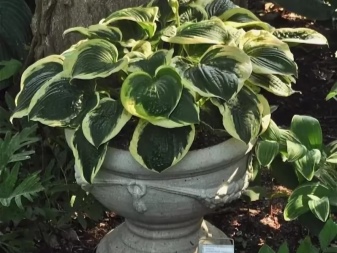
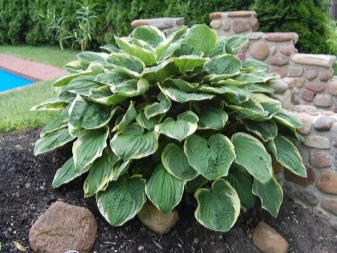
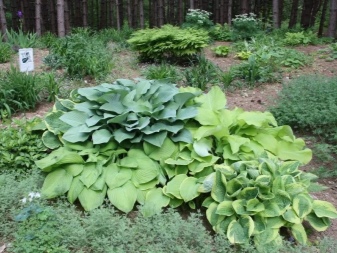
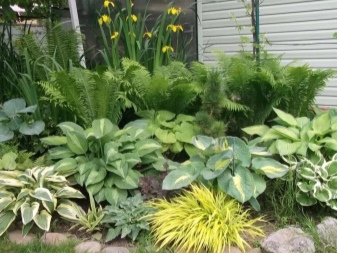
Review and characteristics of the Christmas Tree host await you next.
Description of culture
An ornamental variety is a perennial herb belonging to the Asparagus family. Under natural conditions, the culture grows in the Far East, in China and Japan, as well as on the island of Sakhalin. The moisture-loving shrub prefers places with natural reservoirs near rivers, ponds and lakes, but can also grow in forests and on mountain slopes.
The characteristics of the plant are as follows.
- The hosta root system is powerful, rapidly growing, helping the variety to survive in severe frosts.
- The shrub is 50-60 cm in height, the length of the peduncles is 35-45 cm.
- The diameter of the leaves of the shrub is striking - 70-90 cm, the leaf plates are heart-shaped in shape, their surface is distinguished by a beautiful dense texture and embossed grooves. Above, the leaves are dull, their underside has a light bluish bloom.
- The color of the leaves is deep emerald, the edging is yellow, eventually turns white. The leaves grow in several pieces, forming a rounded rosette.
- Hosta flowers are funnel-shaped bells of a pale lilac color, collected in beautiful brushes, but in order to maximize the beauty and size of the foliage, gardeners cut them, directing the energy of the shrub to the growth of the leaves.
- The bush blooms in the second decade of June, and flowering continues until September. The fruits of the Christmas Tree hosts are brown pods with seeds 2-3 mm long.
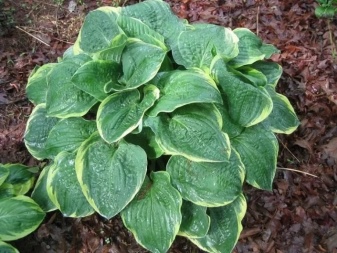
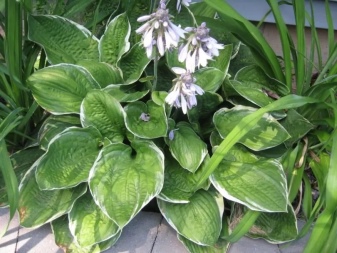
The variety is well adapted to survive in cold winters; it easily tolerates frosts down to -30 -40 degrees. In central Russia and more northern regions, gardeners often use the plant to decorate the suburban area, without fear of freezing the branches.
WAFFLE HOSTS

Hosts attract not only with different colors, there is a large group of varieties with crinkled, bumpy, waffle leaves that always look interesting and unusual. There are already a lot of such varieties, I will try to tell you about the ones I like most.
I'll start with the award-winning hosts American Halo (Van Wade, 1999). This is a wonderful variety up to 55 cm high. An intense blue leaf is surrounded by a wide creamy white border, and its color does not change until the end of the season. The only pity is that this host grows rather slowly.
The popular Band of Gold (Ed Elslager, 1999) has been a popular favorite for many years thanks to a crinkled leaf with a wide creamy yellow border and a fancy blue-gray pattern in the center, similar to the outline of a maple leaf. Quite a large hosta with a height of 50-60 cm and a diameter of 75 cm.
Hosta Big Daddy (Paul Aden, 1978) exhibits cupped, rounded leaves with a distinct waffle texture and a persistent clear blue color. Due to the density of the foliage, the variety is considered slug resistant. Large hosta, with age it reaches 90cm in width.
Another powerful variety is Black Hills (B. Savory, 1983), its bush reaches 1 m in diameter.The leaves are round, dark green with a metallic sheen. Outstanding hosta with dark flowers and very dark foliage.
One of the largest blue hosts, the Blue Mammoth (Paul Aden / Pete & Jean Ruh, 2010), features a 1 x 1 m domed shrub and cascading foliage. It is "arranged" so that an adult bush resembles a layer cake in shape. Not many host varieties adorn flowering, and the "blue mammoth" is one of those few. Tall flower stalks up to 1.2 m high with many light lilac bell flowers look very exotic.
Brother Stefan (Petryszyn, 1998) is an elegant hosta with thick, strong leaves on long petioles. The center of the leaf is golden, and a wide border of various shades of green creeps into the middle of the leaf with beautiful tongues. The bush is wide, grows well (left).
Another Christmas Tree waffle (Kevin Vaughn & Mildred Seaver, 1982) exhibits a rounded matte green leaf with a thin white edge. The bush is very dense, in the form of an irregular dome. The variety is unpretentious and grows well. But why was it called the "Christmas tree"?
Good old Elegans (Arends & Hylander & AHS, 1987) forms a large bush more than 1 m wide. The foliage is bluish with a dense gray "dusting", which is slightly washed away by rains in the second half of summer. The well-defined waffle is striking.
Hosta Flavocircinalis (Maekawa, 1987) is relatively low (35-45 cm), but her bush is very wide (1 -12 m) and grows rapidly. The leaf is dense, gray-blue with a golden border creeping into the center. The waffle texture is printed very clearly on it (right).
Golden Sculpture (Ken Anderson, 1982) resembles a huge vase (70 cm high) thanks to its powerful vertical leaf stalks. The leaves themselves are chartreuse with an apple shade with a corrugation that enhances the impression of the waffle roughness.
Lakeside Prophecy (Mary Chastain) is a medium to large variety with a unique green, ruffled, highly bubbly foliage similar to crocodile skin. This variety stands out for its relief from the rest.
Potomak Pride (Tony Avent, 1995) is attractive with a dense, shiny dark green wrinkled leaf. An additional piquancy is given by lilac spider-shaped flowers. Bush 60-70 cm high, up to 90 cm in diameter. Stylish hosta!
But it is worth noting that for all hosts with such structural foliage, it takes time to come into effect, to grow a bush, in order to fully demonstrate the "brutal" texture. Therefore, do not be discouraged right away if the young division does not show a clear relief, be patient for at least a couple of years.
A. KONYUKHOVA
Landscape use
The neatly pyramidal Christmas tree host can serve as a tapeworm or addition to a group composition. Often used as a groundcover, living curb, flower bed and lawn surround. It soothes and harmonizes bright flower gardens, organically blends into natural-style landscapes.

Christmas tree host
The function is well suited for decorating alpine slides, rocky gardens, rockeries. It can be grown in a container, which will allow you to decorate a small patio, gazebo, terrace, veranda.
The culture goes well with ferns, gladioli, lilies, iris, delphinium. It often serves as the first tier in mixborders, emphasizing the beauty of conifers and getting a slight partial shade from them.
"Gray" or silvery host varieties
Another direction of breeding is the creation of "gray" and silver varieties, often indicated by the word silver ("silver") in the name. In particular, it is found in very beautiful hosts. Silver light ("Silver light"). Her wax coating really shines with silver, but its presence creates certain problems. It is advisable not to touch the plant during weeding, water should not get on it, therefore watering is strictly at the root. Otherwise, this hosta can look pretty shabby by the end of the season.
Hosta appeared on the market in 2009 Astral bliss ("Astral bliss") with intensely silvery-blue leaves, shaped like arrowheads. The star-shaped form of the bush is remarkable. New in 2016 - an elite variety with a gray bloom Winter frost ("Winter frost"), with tough leaves with ruffles along the edge and clearly defined veins. In a row of smoky varieties and whitish hosta London Fog ("London Mist"), as well as a mesmerizing, fully true to its name, smoky variety Hypnosis ("Hypnosis"), which appeared on the market in 2015. This extraordinary hosta has rather large emerald-green leaves with a speckled white-pistachio border, which makes it very recognizable.
To the famous smoky variety Split Milk ("Spilled milk") one more was added - Spoiled Milk ("Sour milk"). The leaves of this hosta are covered with irregular whitish spots and streaks on a blue-green background, almost like a lungwort. A very rare and spectacular host!
On the basic principles of agricultural technology
Even a beginner in floriculture will not be difficult to grow a host, since it is a rather unpretentious plant. It is not afraid of frost and does not need regular feeding, and also tolerates both drought and frost without any negative consequences.
Important! The thicker the shadow, the slower the hosta grows, but its leaves become much larger under these conditions.
Soil requirements
Hosta grows best on moderately moist soils enriched with humus. A neutral or slightly acidified soil is suitable. On sandy and loamy soils, plants do not take root well.
Landing in open ground
Hosta is usually planted in the spring, at the end of April. It is better to do this when the threat of the last frost has passed. Can also be planted hosta in September.
Planting holes for the host are placed at a distance of 30-80 cm, depending on the variety. Strongly branched bushes are planted at a distance of 100 cm from each other. After planting, they are abundantly watered and mulched: for this you can use sawdust or bark.
Watering
It is very important to water the hosts on time, as the soil around them should be slightly damp all the time. It is better to do this in the morning or in the afternoon, but in cloudy weather, since watering in midday light can provoke leaf burn
Important! Watering is done at the very root, since the leaves covered with moisture can attract pests - snails and slugs
Preparing for winter
In September, the host begins to prepare for wintering. To do this, almost the entire ground part of the plant is cut off in order to get rid of possible pests that often hide in the foliage. You do not need to cover the plants additionally, but you can mulch them for better wintering.
Buy / order Hosta Krismos Three (ML) in the nursery. Mail delivery | Online store of garden plants
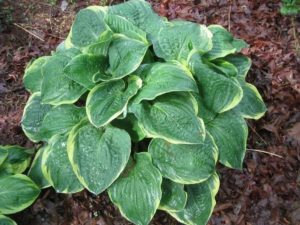
Hosta Christmas Tree - The leaf blade is very dense in size, from olive green to dark green with a slight bluish bloom at the beginning of the season, with a narrow, uneven creamy border, which then turns white, with intermediate grayish-green stripes located towards the main (middle ) leaf vein, dull above and with a bluish bloom below, strongly reaped in adulthood, slightly wavy edge. The leaf is broadly oval to nearly round, with a sharp tip (dropper) and cordate tapering lobes (base). The petiole is dark green, with a thin white outline. The flower is funnel-shaped, pale lavender, on a straight, leafy, gray-green peduncle.
Description of Host Christmas Tree. Leaf blade 21 x 16 cm. Peduncle 45 cm high. Bush up to 50 cm high. Bush width up to 90 cm. Flowering period July-August. Winter hardiness zone: 3 (-40 ° С)
Hosta, or funkiya, is a perennial herb of the Liliaceae family. The hosts are home to China and Japan. It is an ornamental deciduous perennial. Hosta leaves are about 20 cm long, up to 10 cm wide, located on petioles and form a large basal rosette.
They can have various shapes and colors, be monochromatic or with edging, with or without a wax coating, with a straight or wavy edge.The flowering stems are glabrous, from 20 to 100 cm high. The flowers are bell-shaped or funnel-shaped, blue, lilac or white, collected in racemose inflorescences.
Hosta blooms in July-August.
Landing site for Hosta Christmas Tree. Hosts can grow in both shade and sun, but most of them prefer slightly shaded areas. Variegated species are more light-loving. Plants need protection from drafts and strong winds. The soil for the host is suitable for fertile, moist enough, but without stagnant water.
Planting Host Christmas Tree. Before landing, the hosts dig up a plot of 1 sq.m. add a bucket of humus and a complete mineral fertilizer.
Small holes are dug at a distance of 30-50 cm from each other, corresponding to the size of the root system. Drainage is laid at the bottom, garden soil is poured, rhizomes are placed, spreading the roots, and covered with garden soil on top.
The soil is compacted, well watered, planting is mulched.
Host Christmas Tree care. The hosts do not need special care. Plants must be watered in a timely manner, weed out, fed with organic matter or mineral fertilizers.
An excellent technique is the surface mulching of the soil with humus, it allows you to retain moisture and creates favorable soil conditions for the plant. In autumn, the hosts are not pruned, only the peduncles are removed.
They also do not need shelter for the winter, the culture tolerates frosts down to -40 ° C.
Reproduction of the Host Christmas Tree. Propagated by host separation of the bush and cuttings. Adult shrubs are divided in early spring (before early May) or autumn (in September). To do this, the plant is abundantly watered, dug up and divided into several parts, so that each of them has 1-2 leaf sockets.
The resulting cuttings are immediately planted in a permanent place. Hosta cuttings can be carried out throughout the summer. To do this, young shoots with a heel are separated from the plant, the leaves are cut by a third, planted in a shady place, covered with a plastic bottle. In the first days, the leaves will lie on the ground - the turgor is lost, but after a couple of weeks the cuttings will take root.
Using the Christmas Tree Host in your garden design. Hosta is great for landing along the shore of a reservoir, for rocky gardens, mixborders, planting along paths. It looks impressively planted in groups against the background of an emerald lawn. Ornamental hosta leaves are widely used to create bouquets.
We store plants ready for shipment under special conditions. We pack the parcels in a reliable way. We inform about the shipment and control the parcel on the way.
We work on 100% prepayment to reserve the best varieties for you and guarantee delivery on time without postage and commissions.
New host varieties
The work of breeders in recent years has been aimed at obtaining varieties with the presence of red or purple hues in the color. Plants can have colored petioles, veins of leaves (some originators even call them "veins"), partially leaves - all this not only gives the hosts a special charm, but also distinguishes them from the general series.
New varieties continue the list of already known and beloved red-peted varieties: Red october (with the revolutionary name "Red October", Fire island ("Burning island"), Cherry berry ("Cherry"), Cinnamon sticks ("Cinnamon sticks").

So, the first blushing host appeared First blush ("First blush"), which not only has "legs" and veins of the color of red currant, but also along the edge of the leaf there is a thin red border, which, as the leaves bloom, spreads over the leaf blade in irregular glowing spots. Prior to that, a variety was obtained with the self-explanatory name "beet salad" (Beet Salad), somewhat resembling chard leaves.
Another notable variety is Purple haze ("Violet haze"), in which the entire plane of the sheet is covered with a light violet dusting - it is best manifested in full shade 
(!) and in a cool climate - a very suitable choice for Russian conditions.
The hosts Purple heart ("Purple heart"), new in 2012, a maroon spot at the base of the leaf, glossy green leaves with pale-yellow tints on crimson "legs", also a vase-shaped bush. It is considered a hosta with the maximum presence of a crimson-red color, which spreads along the veins almost to the middle of the leaf. Peduncles - the same bright color as the petioles, with pale purple flowers.
Another variety already appreciated by Russian collectors is Azuretini, registered in 2009. This hosta has a silvery-green leaf on a white lining, red-purple tall petioles and a vase-shaped bush in order for this beauty to be all that is 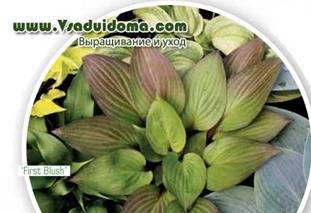
the world's fashion host - to demonstrate to others.
From the same row and a relatively old (1999) variety Fruit Punch ("Fruit punch") with arrow-shaped wavy kiwi-colored leaves, the sharp tip of each is painted in a red-purple color, the same bright "legs".
But the main feature is the purple flowers with white edging!
Notable also Strawberry Surprise ("Strawberry surprise") with heart-shaped leaves with a yellow border, pink bloom on the lower leaf blade and pink petioles; Red Scorpion ("Red scorpion"), medium sized hosta with shiny ruffled dark green leaves and purple petioles, new in 2017; Blueberry Muffin ("Blueberry muffin") with heart-shaped blue leaves on purple-violet petioles.
New in 2015, another red-legged host Red Bull ("Red bull"), has heart-shaped, dense, bright green leaves with deep veins, a drawn tip and a white lining. In the same year, a new host was announced Jessica Alba, a sport from a famous variety Marilyn Monroe... Extremely ornate, slightly twisted golden yellow leaves with a ruffled edge and a white underside sit on reddish petioles. In spring, the tips of the leaves are colored red.
A medium-sized variety known since 2015 Almost ("Almost"), characterized by the brilliance of emerald leaves, in the center of which there is a small red stroke. The stalks of this extraordinary hosta are dark red, now on sale Stephen
King, medium sized hosta with slightly twisted green leaves, dark red-purple to black, petioles and purple-red peduncles. Two more varieties were recognized as masterpieces of the American Valley nursery: Valleys Karma and Infatuation  ("Infatuation"), both with black and purple "legs".
("Infatuation"), both with black and purple "legs".

